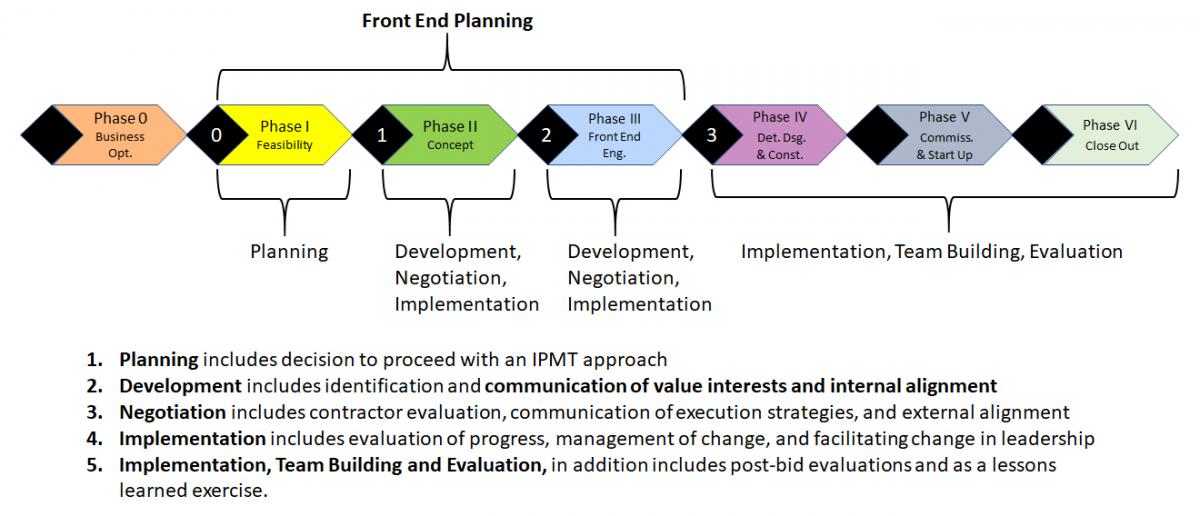Recent project data indicates that the industry has a difficult time accomplishing basic alignment between owners, contractors, and suppliers with common practices, from early conceptualization through construction. In many cases, there is limited effective alignment and coordination across all parties in the execution phase.
Numerous studies have shown that project failures are more often caused by organizational and human error, rather than technological reasons. Integrated Project Management Teams (IPMTs) hold great promise in addressing these organizational and human factors by bringing together all the key stakeholders in a collaborative team environment (collocated or virtual) to address the most important decision points throughout the project lifecycle. However, ineffective formation and management of IPMTs often cause them to have the same difficult organizational dynamics they are created to address.
Forming and managing an IPMT is not just a matter of following certain steps; it requires periodic evaluation and adjustment. Key Performance Indicators (KPIs) should be implemented together with the IPMT, allowing its stakeholders to quickly evaluate how well the project is progressing so that actions can be made as required.
The essence of the IPMT approach is to assemble the different areas of expertise needed to develop a project, together with the authority and responsibility to design, procure, install and start up a project in a single organization. Under the IPMT approach, each team possesses the knowledge to collaboratively identify problems and propose solutions, minimizing the amount of rework that has to be done. IPMTs evolved as a more holistic approach, reducing interfaces among organizations and allowing representatives from each stakeholder to come together as a team and work directly with each other throughout all phases of the project. Recent experience has shown that IPMTs must be formed and supported with even more care than other workgroups because of the difficult dynamics inherent in such a diverse collection of team members (skills, culture, processes) and because the team’s capacity for consensus building is essential. This is the very reason that integrated project teams are so popular with management.
The most critical aspect of forming the IPMT is to assemble the team early in FEL - FEL2 if possible. This permits the Team to contribute to project planning and facilitate a culture of open collaboration and transparency. It is very difficult to change implementation once the FEED process has started without the IPMT concept and rolling it out through the execution phase. Again, since harmony is critical, selection of the IPMT needs special attention when considering the challenging dynamics of the diverse job responsibilities. A clear communications plan, roles and responsibilities, project drivers and expectations in place are required.
The following Figure illustrates the IPMT implementation process during the life of the project:

By respecting the experience and expertise of the extended project management team (Suppliers and Contractors), the project is able to harvest the benefits of that experience to ensure project success. The team culture should be built around honesty, integrity, open discussions (agree or disagree) on ideas and innovative concepts.
Understanding the differences between a traditional Project Management Team and an Integrated Project Management Team is an important element in identifying the keys to successful collaboration. Below is a graphic from the Construction Industry Institute’s Industrial Integrated Project Delivery (I2PD) showing the several elements that are the same for the two approaches. Still, many others, such as relational contracting, shared risk/rewards, equitable decision-making, liabilities waivers, etc., have strong relevance in the IPMT consideration.

Proper completion of the following elements will ensure successful execution of a project under an EPCM Integrated Project Management Team.
- Define the need: Clearly define the need to apply an IPMT approach. A key question to be answered is: at what points in the project lifecycle do particular stakeholders need to be involved and what is the nature of that involvement?
- Identify & Mapping Stakeholder Involvement: The identification of stakeholders and their involvement should typically be mapped over each phase of the project lifecycle.
- Planning: The biggest key to the success of an integrated project is planning collaboratively, clearly defined project outcomes, and planning for that as much as possible.
- Design the IPMT Structure: Define where an IPMT approach needs to be applied during each project phase. A single IPMT may oversee an entire project over its entire lifecycle, or IPMTs may be formed and deployed at any stage of the project lifecycle, from the initial project definition phase through the operational phase or any point in between. Develop roles and responsibilities and define Delegation of Authority.
- IPMT Project Manager Selection: The right leadership of a team is essential to its success. The project manager should be familiar with the stages of IPMT and be able to implement them. A leader must have good communication skills and encourage team members to openly exchange ideas. A project manager also must be diligent at monitoring developments and be able to manage team activities in the moment. An effective leader also works to build the team, provides rewards and recognition to increase motivation, and acts as a mentor.
- IPMT Membership Selection: The selection of members who will effectively represent their constituent organizations or functions but also participate as part of a team in achieving consensus with other members and sharing accountability for the team’s success. It is important to have a strong relationship with contractors and suppliers (engineering firms, construction contractors, etc.) based on respect and trust to incorporate them in the IPMT.
- Providing Innovation Support: A valuable aspect of working in such a diverse collaboration is the fresh perspectives and solutions that can come from anyone on the team. Keep an open mind, and make sure that everyone feels welcomed to contribute. There are no wrong answers or ideas in an integrated working environment.
- Forgetting Silos: They may be entrenched and hard to escape, but silos are the antithesis of integration and need to be eliminated to create successful projects.
- Risk Management Identification: Risk avoidance and mitigation is one reason to use IPMT since it is an integral component of the project planning process. Start by focusing on predictable and known risks and review lessons learned from past projects and adjusting them to fit the scope of the current project. You can also look at risks based on goals and desired project outcomes.
- Define and Track with Key Performance Indicators (KPIs): Keeping an eye on performance metrics is fundamental to the monitoring of progress goals and is integral to every IPMT process. By using dashboards, team leaders and members have a visual snapshot of where they are, related historical trends, and the enablement of better, more informed decisions with real impact.
In summary, the IPMT aims to optimize the project performance by joining the best forces of the Owner, the engineering firm (s), and construction contractor (s) based on mutual understanding and trust. IPMTs won’t work unless the project stakeholders can change their thinking and move beyond the adversarial mindset inherent in traditional project delivery methods. It requires each party to consider how their work will impact the project and its success as a whole.
ABOUT THE AUTHOR:
 Maria Lizardo
Maria Lizardo
Maria is a Vice President with Pathfinder, LLC and has over 40 years of experience in the Oil & Gas Industry.
mlizardo@pathfinderinc.com
856-424-7100 x137

